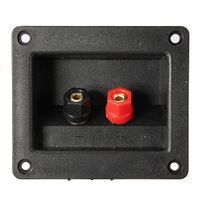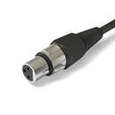Audio Cables
There are many kinds of audio cables. We will only cover some of them here - the ones used by ARTC.
An audio cable usually conveys analog electrical signals through cables made of copper wires. Digital cabling is rarely used by ARTC (currently) except of computer interfaces. We will put off talking about those for now.
A cable is usually described by the following attributes:
- The length of the cable (often given in feet or inches)
- The connectors (ends) of the cable
- The number of channels in the cable (Mono or Stereo)
Length of Cable
- Very Short - a few inches to about a foot
- Short - a few feet long
- Medium - between 6 and 10 feet
- Long - more than 10 feet
- REALLY long - something that can stretch across a stage or longer
Cable Connectors
This is the heart of cable descriptions. A cable connector is usually described by
- The diameter of the metal part of the connector
- Its shape
- Its sex (male and female) - this is left as an exercise for the reader.
Since there are two ends of a cable it can have completely different connectors on each end.
Let's look at some connectors
Phono Connectors
Phono connectors are the most common connectors for analog audio that connects one audio processor to another.
RCA Phono
The RCA phono connector was invented by the company RCA to connect phonograph players to other sound equipment. It is mostly used with non-professional equipment (home audio). ARTC does not use this connected much but in the past we used it with some "home equipment" (like cassette players and CD players).
NOTE: these are sometimes called "RCA pin plugs."
1/4" Phono
This is the most commonly used analog phono connector in professional audio. It is sometimes just called a "phono plug".
(Please note that the just the ends on the left of each picture are the 1/4" Phono ends!)
1/8" Phono
Originally invented for small, portable home audio devices it has become very popular in some parts of professional audio because of its convenience.
NOTE: This is also called a "3.5mm phono" or a "phono mini."
XLR Connectors
Used a lot in professional audio. These are used to connect microphones to mixers, and the snake, and can be used to connect speakers.
Speaker Connectors
There are a lot of ways to connect speakers and this can be complicated by the fact that some speakers have built in amplifiers and some do no. If speakers have their own built in power they are often connected by normal audio cables such as XLR cables and phono cables.
Bare Wire
Annoyingly enough this is one of the most common ways of connecting an unpowered speaker to an amplifier. The bare wire cable is two separate wires that are encased in the same cable together. This cable can be split apart to go into the posts on the amplifier and the speaker.
Split speaker wire:  Bare wire connector on a speaker:
Bare wire connector on a speaker: 
There is a difference between the two sides of the split speaker cable. Sometimes the casing for a wire has different colors: red and black. Sometimes the casing has an extra pale white stripe along the length of the wire. This can be very subtle.
It is important that the speaker cable is connected so that the same orientation is used for both speakers going from an amplifier. It is recommended that the marked side of the cable (the red one or the one with the stripe) always be connected to the red terminals on the amplifier and the unmarked side of the cable (the black one or the one without the stripe) to the black terminals.
This is easier to do if the speaker and the amplifier supports banana plugs.
Banana Plugs
The female style of the banana plug, the one that in mounted on the speaker and the amplifier looks like this:
 The male end like this:
The male end like this:

The male banana plug is often a stand-along adapter where you can attach the bare wires by screwing them into the plug. Remember: red for the marked side of the wire and black for the unmarked side.
Speakon
We do not currently have any Speakon connections. This section will be improved later.
Channels of a Cable
Most of the cables are any mono or stereo. The mono cables carry the signal for one channel and the stereo cables carry signals for two channels. The mono cables are easy so we will pretty much ignore them in this section. The stereo cables can get complicated.
Stereo cables have two separate wires within the cable, shielded from each other. When the connector is placed on the end of the cable we usually get two connectors: one for the left channel and one for the right. Or sometimes we will get a single connector with multiple "bands" on the metal part of the connector.
Dual Connector Ends
With the dual connector ends one connector is the left channel and one connector is the right channel. Ah, but which one is which. The simple explanation is that the "marked" connector is the right channel and the "unmarked" connector is the left channel. That's nice. Which one is marked.
Here are the rules:
- Red connector is ALWAYS the right channel
- Black connector is ALWAYS the left channel
- White connector is PROBABLY the left channel
- Grey connectors can be either - and depend on the color or the other connector
- If the other connector is black, then the grey connector is the right channel
- If the other connector is red, then the grey connector is the left channel
- If the other connector is white, then the grey connector is probably the right channel. Probably.
- Yellow connector is VIDEO. This only happens when you have 3 connectors on the cable.
- Connectors with RED, GREEN, and BLUE are composite video cables. Don't use them here.
Single Connector Stereo Ends
The RCA phono connector do not support a single connector Stereo end. These are supported by Phono (1/4") and Phono mini (1/8") connectors. They are supported by having two "bands" of metal on the connector which have the left and right channel. See pictures below.
With these single connector you do not have to worry about connecting the left and right channels correctly that is all done for in the structure of the connector.
The pictures below show connecting cables that have a banded phono connector on one end and a pair of stereo RCA phono connectors on the other end.
IMPORTANT: The mono phono cables are also called "unbalanced" cables and "TS" (Tip-Sleeve) cables. The stereo cables are also called "balanced" cables and "TRS" (Tip-Ring-Sleeve) cables.
The cables are the same - it just depends on what signal the source generating. Thus a source can be generating a separate left and right channel, but each channel has a balanced signal. You should use two balanced cables, one for left and one for right.
Using a balanced cable when the source is unbalanced does no harm. So it is good to have a lot of balanced cables around.









